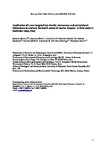Application of a new targeted low density microarray and conventional biomarkers to evaluate the health status of marine mussels: A field study in Sardinian coast, Italy
| dc.contributor.author | Sforzini, S | |
| dc.contributor.author | Oliveri, C | |
| dc.contributor.author | Orru, A | |
| dc.contributor.author | Chessa, G | |
| dc.contributor.author | Pacchioni, B | |
| dc.contributor.author | Millino, C | |
| dc.contributor.author | Jha, Awadhesh | |
| dc.contributor.author | Viarengo, A | |
| dc.contributor.author | Banni, M | |
| dc.date.accessioned | 2018-09-13T11:31:08Z | |
| dc.date.available | 2018-09-13T11:31:08Z | |
| dc.date.issued | 2018-07-01 | |
| dc.identifier.issn | 0048-9697 | |
| dc.identifier.issn | 1879-1026 | |
| dc.identifier.uri | http://hdl.handle.net/10026.1/12352 | |
| dc.description.abstract |
In the present study, we investigated the health status of marine mussels (Mytilus galloprovincialis) caged and deployed at three different sites on the Sardinian coastline characterized by different levels of contamination: Fornelli (F, the reference site), Cala Real (CR), and Porto Torres (PT). A new low density oligonucleotide microarray was used to investigate global gene expression in the digestive gland of mussels. Target genes were selected to cover most of the biological processes involved in the stress response in bivalve mollusks (e.g. DNA metabolism, translation, immune response, cytoskeleton organization). A battery of classical biomarkers was also employed to complement the gene expression analyses. Chemical analysis revealed higher loads of heavy metals (Pb and Cu) and total polycyclic aromatic hydrocarbons (PAHs) at PT compared to the other sites. In mussels deployed at CR, functional genomics analysis of the microarray data rendered 78 differentially expressed genes (DEGs) involved in 11 biological processes. Animals exposed at PT had 105 DEGs that were characterized by the regulation of 14 biological processes, including mitochondrial activity, adhesion to substrate, DNA metabolism, translation, metal resistance, and cytoskeleton organization. Biomarker data (lysosomal membrane stability, lysosomal/cytoplasm volume ratio, lipofuscin accumulation, metallothionein content, micronucleus frequency, and cytoskeleton alteration) were in trend with transcriptomic output. Biomarker data were integrated using the Mussel Expert System (MES), allowing defining the area in which the presence of chemicals is toxic for mussels. Our study provides the opportunity to adopt a new approach of integrating transcriptomic (microarray) results with classical biomarkers to assess the impact of pollutants on marine mussels in biomonitoring programs. | |
| dc.format.extent | 319-328 | |
| dc.format.medium | Print-Electronic | |
| dc.language | en | |
| dc.language.iso | en | |
| dc.publisher | Elsevier | |
| dc.subject | Biomarkers | |
| dc.subject | Targeted microarray | |
| dc.subject | Mussels | |
| dc.subject | Data integration | |
| dc.title | Application of a new targeted low density microarray and conventional biomarkers to evaluate the health status of marine mussels: A field study in Sardinian coast, Italy | |
| dc.type | journal-article | |
| dc.type | Journal Article | |
| plymouth.author-url | http://gateway.webofknowledge.com/gateway/Gateway.cgi?GWVersion=2&SrcApp=PARTNER_APP&SrcAuth=LinksAMR&KeyUT=WOS:000432462000035&DestLinkType=FullRecord&DestApp=ALL_WOS&UsrCustomerID=11bb513d99f797142bcfeffcc58ea008 | |
| plymouth.volume | 628-629 | |
| plymouth.publication-status | Published | |
| plymouth.journal | Science of the Total Environment | |
| dc.identifier.doi | 10.1016/j.scitotenv.2018.01.293 | |
| plymouth.organisational-group | /Plymouth | |
| plymouth.organisational-group | /Plymouth/Admin Group - REF | |
| plymouth.organisational-group | /Plymouth/Admin Group - REF/REF Admin Group - FoSE | |
| plymouth.organisational-group | /Plymouth/Faculty of Science and Engineering | |
| plymouth.organisational-group | /Plymouth/Faculty of Science and Engineering/School of Biological and Marine Sciences | |
| plymouth.organisational-group | /Plymouth/REF 2021 Researchers by UoA | |
| plymouth.organisational-group | /Plymouth/REF 2021 Researchers by UoA/UoA06 Agriculture, Veterinary and Food Science | |
| plymouth.organisational-group | /Plymouth/Research Groups | |
| plymouth.organisational-group | /Plymouth/Research Groups/Marine Institute | |
| plymouth.organisational-group | /Plymouth/Users by role | |
| plymouth.organisational-group | /Plymouth/Users by role/Academics | |
| plymouth.organisational-group | /Plymouth/Users by role/Researchers in ResearchFish submission | |
| dc.publisher.place | Netherlands | |
| dcterms.dateAccepted | 2018-01-28 | |
| dc.rights.embargodate | 2019-2-13 | |
| dc.identifier.eissn | 1879-1026 | |
| dc.rights.embargoperiod | Not known | |
| rioxxterms.versionofrecord | 10.1016/j.scitotenv.2018.01.293 | |
| rioxxterms.licenseref.uri | http://www.rioxx.net/licenses/all-rights-reserved | |
| rioxxterms.licenseref.startdate | 2018-07-01 | |
| rioxxterms.type | Journal Article/Review | |
| plymouth.funder | Elucidating the potential interaction of manufactured nanoparticles with polycyclic aromatic hydrocarbons: An integrated toxicogenomics approach::NERC |


